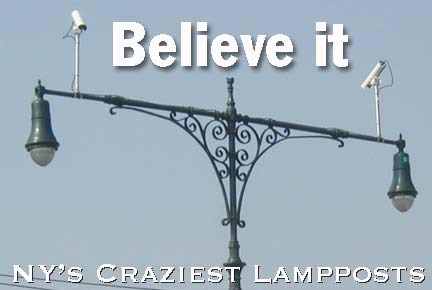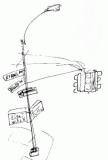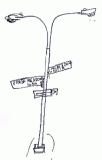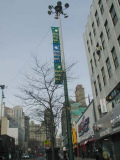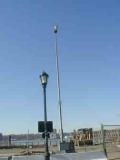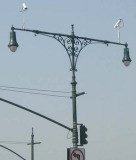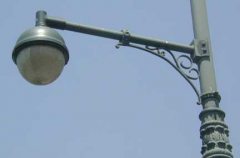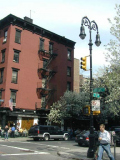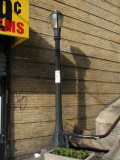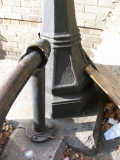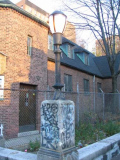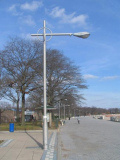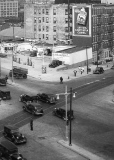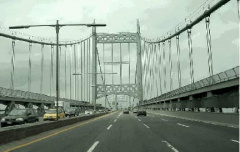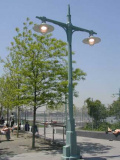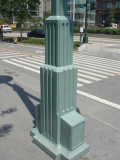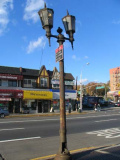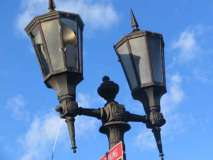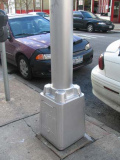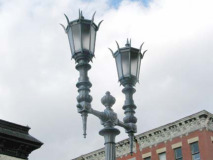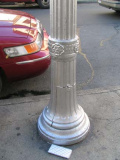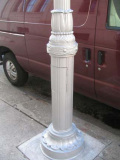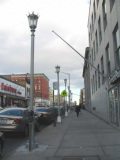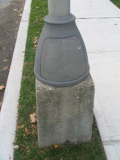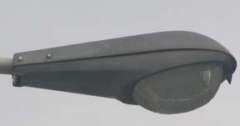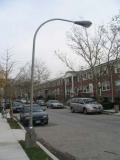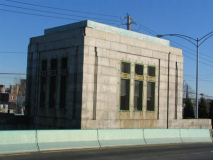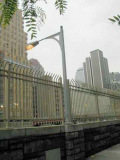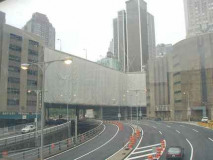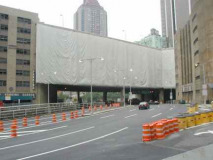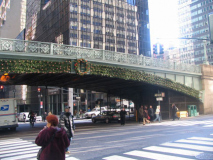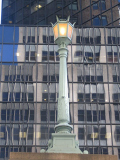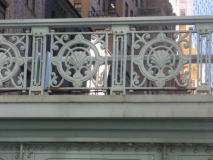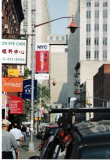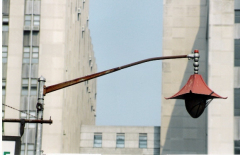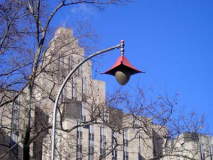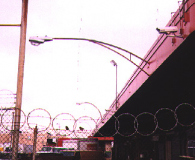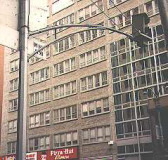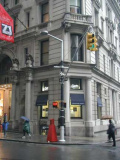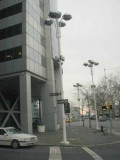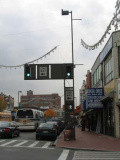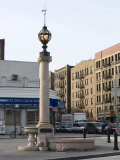IT’S ALWAYS FUN when it’s time to do a lamppost page in Forgotten NY, because these vaguely anthropomorphic untility poles are what got me started with this Forgotten NY stuff decades ago. My parents used to take me for bus rides all over Brooklyn, and I could never be seen without a pencil, a spoon, and one of those little bulbs you find in flashlights. Yes, I used to create my own lampposts, or recreate the ones I saw out the bus window. When I got home, I would fill tablets with pictures of lampposts, and still do, occasionally, to the present day…
A 1960s octa-pole with cobra neck and fire alarm light…
An M-2 guy-wired stoplight with cobra attachment…
…and a double Desky!
I’ve been doodling like this as far back as I remember. I think it captures the look and feel of NYC lampposts don’t you? Look out Ben Katchor!
Anyhow, on this page we’re going to feature several lampposts found on NYC streets that don’t fit the usual canon: the silver octa-poles with their panoply of masts and luminaires, or the legions of retro-poles, the longarmed Corvingtons and curved bishop crooks that have taken over several neighborhoods. In some areas, specialty poles have been installed to fill certain niches that the general-issue poles can’t address. In other areas, there are lamps that have been privately installed by property owners and have been co-opted by the city. Other lamps are just plain wacky.
Left: 11th Avenue and West 34th Street, Javits Center
Center: Fulton Mall and Jay Street, Brooklyn
Right: 12th Avenue, Tribeca
Sometimes, you want an especially intense light mounted on a pole that towers over all opposition, like the Shaq or Yao Ming of lampposts. You can find them at the Jav and the Fulton Mall. NYC’s tallest lampposts of all used to be found on West Street and 12th Avenue, on the surface highway that replaced the elevated West Side Highway and was supposed to be replaced by Westway. The current specimen shown at right is one of only two that remain from the 1980s, when they were installed.
Today, the rechristened Joe DiMaggio Highway (really West Street and 12th Avenue now that all hope for an underground highway topped by parkland has been suppressed by NIMBYs) is lined by retro-Corvingtons, those long-armed poles first produced in the 1910s to light wider boulevards and parkways, and classified as Type 24M by the System Electric Companies: Photographs of Street Lighting Equipment, a pamphlet produced by NYC’s Bureau of Gas and Electricity in 1934.
When the classic poles were relaunched by NYC’s Department of Transportation beginning in the 1980s, many of the old classics didn’t fit modern modes of traffic, so they got tinkered with. The classic Corv, Type 24M, didn’t have a twinlamp form: there was already a model that fit that bill: the Type 24 Twin. Those twins, though, don’t have the reach to illuminate the DiMag, and so these special new twin Corvs were created. All the new poles are modular in form, and the Type M2 stoplight, developed in the 1950s, can have a retro-Corv extension slapped onto its apex, as we see here. The classic feel, though, is somewhat compromised by the two cameras, looking for red-light runners, affixed to the masts!
CENTER: The DiMaggio Corvingtons have mini-masts lighting the bike paths and sidewalks supporting what appear to be newer versions of the 1930s-1940s gumballs.
RIGHT: the oddest new twinlamp I’ve seen, though, is on Irving Place and East 18th Street, across the way from the legendary Pete’s Tavern: a double bishop crook! Is this a terrific innovation…or is it blasphemy? To me it looks like one of those two-headed turtles or snakes that hatch once in a while.
Lampposts illuminating step streets, found mostly in Manhattan and the Bronx, seem to be in a classification all their own. Sometimes, regulation Henry Bacon-type park posts are used, but then you find a genus that has no relation to any other NYC post, like the 2 posts at left, on Godwin Terrace near Broadway in Kingsbridge, or the one at right, on the Summit Place steps in Kingsbridge Heights.
The public works of the late 1930s and early 1940s brought the first ripplings of streamlined lamppost design. The Moderne pole at left was placed in the parking lot adjacent to the IND World’s Fair shuttle station, which was dismantled soon after the Fair was closed in 1940, and apparently no trace exists today. The design at right, at the Bronx’ Orchard Beach, can also be found on the boardwalk at Jacob Riis Park. See also: East Side tunnel approach lamps.
LEFT: image from New York, Empire City 1920-1945, by David Stravitz, Harry N. Abrams 2004
The Triboro Bridge, the two-span connector between Manhattan and Bronx and Bronx and Queens, was completed in 1936. Its spired towers on the Queens-Bronx span are echoed in the bridge’s unique lampposts, most of which have now been removed: they can only be found now on the approach roads. Bruckner Blvd. in the Bronx, which connected to the Triboro in Port Morris, got them for most of its length, until they too succumbed when the Bruckner Expressway was completed in 1961. Photo left: nycroads.com; photos right: New York, Empire City 1920-1945
The new park lamps along the DiMaggio Highway from Christopher Street north to West 23rd are close approximations of the old Tribe lamps, albeit shorter. They have stepped bases and apices, like their predecessors: compare the Bruckner pole, above.
Banks sometimes place their own decorative poles on sidewalks facing them. Some, like this one on Hillside Avenue and Homelawn Street, are quite superannuated. Note how the DOT has coopted it to hang a no-parking sign on it. I haven’t been by here at night, does it still work?
The twinlamp apex of the “king” of the poles surrounding the original Greenpoint Bank in Greenpoint, Brooklyn, is interesting enough–it’s almost a duplicate of the Hillside pole — but its single-light “minister” poles are quite intriguing, since they all have different style bases!
Way out east in Glen Oaks, Queens, the block of 65th Avenue immediately east of Douglaston Parkway is lined with short davit poles with concrete bases and variants on the old ca. 1960 Westinghouse Silverliner series of luminaires.
The bridge that takes Cropsey Avenue over Coney Island Creek in Brooklyn dates back to the same era as the Triboro, opening in 1931. Its poles originally supported globe-shaped lamps, then were fitted for cobra necks; today, they’re barren.
The posts on both sides of the Brooklyn-Battery Tunnel are originals, from when the tunnel opened in 1951, and are another early example of the new streamlined style.
Grand Central Terminal, East 42nd-46th Streets between Vanderbilt and Lexington Avenues, was designed and built in 1913 by the Chicago architectural firm Reed and Stem. Among the earliest elements of the design was a viaduct taking Park Avenue around he terminal and through what is now the Helmsley Tower. This ramp and bridge has always boasted a unique lamppost design, and after some years of neglect–even now some of these p[oles are missing–the remaining ones have been given new sodium bulbs and can be expected to light the viaduct for more decades.
Modern glass box towers provide counterpoint to the 1913 poles, designed to match styles of the previous century.
Lyre-shaped masts date back to 1908 and has always been used for decorative or ornamental purposes, since they can’t light a wide area of road. Pagoda-shaped diffusers were used at the dawn of the Deskey era on those posts in Chinatown in the 1960s, but they disappeared after awhile. Both have recently been resurrected. Photos: Diane Goldie.
In very rare cases, the octa-pole double-mast configuration can be oddly used; in midtown, it supports a traffic camera, and in the Brooklyn Terminal Market in Canarsie, it’s divorced from its pole altogether. This mast is never used this way on public streets.
The Alliance for Downtown New York has inflicted a really ugly new lamppost design on Broadway between Bowling Green and Park Place. The question is why? RIGHT: In front of the 1980s building built where Herman Melville was born in the 1800s, and the current home of New York Unearthed, at South and Pearl Streets, you will find these alien-esque posts. Sadly, or perhaps not, they were removed during a renovation in 2010.
LEFT: This was supposed to be the future of lampposts in the 1980s, when business improvement districts erected poles along designated stretches of road. Glad it wasn’t. Above: Jamaica Avenue in Queens; similar poles can be found on Avenue D in Flatbush and elsewhere.
CENTER: Unusual guy-wire traffic stanchions, not the usual M2 types, on Church Street and Park Place downtown. (Also replaced in the mid-2000s)
RIGHT: The Hooper Fountain at West 155th Street and Edgecombe Avenue, bequeathed by adman John Hooper upon his death in 1889, is both a horse trough and an unusual, one-of-a-kind lamppost. It was destroyed by vandals in 1981, but restored faithfully to its original design.

